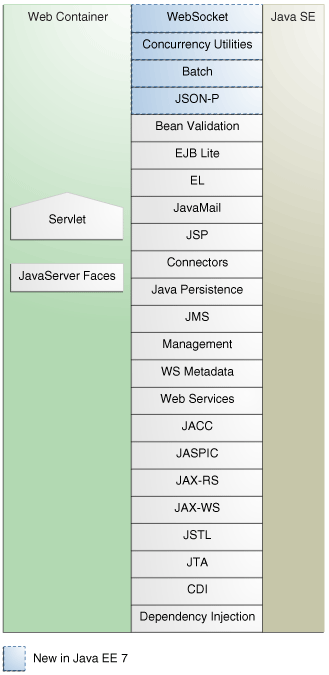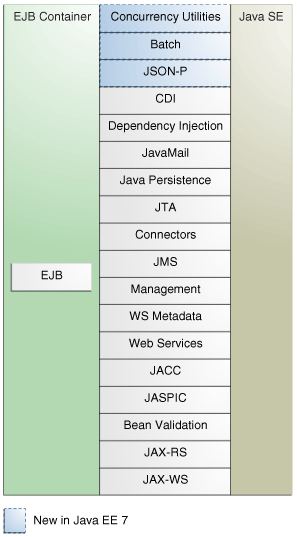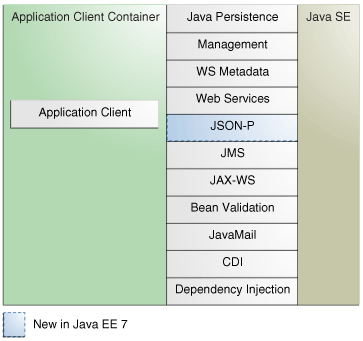原文:http://docs.oracle.com/javaee/7/tutorial/doc/overview007.htm
翻译:石卓林 shizhuolin@hotmail.com
注意:此章是1.8章前移而来,不知为什么oracle删除原1.7开发角色章节
Figure 1⑹ shows the relationships among the Java EE containers.
Figure 1⑹ Java EE Containers

Description of "Figure 1⑹ Java EE Containers"
Figure 1⑺ shows the availability of the Java EE 7 APIs in the web container.
Figure 1⑺ Java EE APIs in the Web Container

Description of "Figure 1⑺ Java EE APIs in the Web Container"
Figure 1⑻ shows the availability of the Java EE 7 APIs in the EJB container.
Figure 1⑻ Java EE APIs in the EJB Container

Description of "Figure 1⑻ Java EE APIs in the EJB Container"
Figure 1⑼ shows the availability of the Java EE 7 APIs in the application client container.
Figure 1⑼ Java EE APIs in the Application Client Container

Description of "Figure 1⑼ Java EE APIs in the Application Client Container"
The following sections give a brief summary of the technologies required by the Java EE platform and the APIs used in Java EE applications.
图 1⑹ 显示了Java EE容器之间的关系.
图 1⑹ Java EE 容器

"图 1⑹ Java EE 容器"简介
图 1⑺ 显示了在web容器中可使用的Java EE 7 APIs.
图 1⑺ Web容器中的 Java EE APIs

"图 1⑺ Web容器中的 Java EE APIs"简介
图 1⑻ 显示了在EJB容器中可用的Java EE 7 APIs.
图 1⑻ EJB容器中的Java EE APIs

"图 1⑻ EJB容器中的Java EE APIs"简介
图 1⑼显示了在利用客户端容器中可用的Java EE 7 APIs.
图 1⑼ 利用客户端容器中的Java EE 7 APIs

"图 1⑼ 利用客户端容器中的Java EE 7 APIs"简介
以下章节扼要叙述了Java EE平台所需技术和Java EE利用中使用的APIs.
An Enterprise JavaBeans (EJB) component, or enterprise bean, is a body of code that has fields and methods to implement modules of business logic. You can think of an enterprise bean as a building block that can be used alone or with other enterprise beans to execute business logic on the Java EE server.
Enterprise beans are either session beans or message-driven beans.
In the Java EE 7 platform, new enterprise bean features include the following:
The Java EE 7 platform requires Enterprise JavaBeans 3.2 and Interceptors 1.2. The Interceptors specification is part of the EJB specification.
1个 企业JavaBeans (EJB)组件或企业bean是1段代码,其有业务逻辑实行模块的字段和方法.你可以认为1个企业bean是1个积木构件,它能被单独使用或作为其他Java EE服务器上的企业beans履行业务逻辑.
企业bean是会话bean或消息驱动bean:
在Java EE 7平台中,企业bean包括以下新功能:
Java EE 7平台要求企业JavaBeans 3.2和Interceptors(拦截器) 1.2. 该拦截器规范是EJB规范的1部份.
Java Servlet technology lets you define HTTP-specific servlet classes. A servlet class extends the capabilities of servers that host applications accessed by way of a request-response programming model. Although servlets can respond to any type of request, they are commonly used to extend the applications hosted by web servers.
In the Java EE 7 platform, new Java Servlet technology features include the following:
The Java EE 7 platform requires Servlet 3.1.
Java Servlet技术允许你定义基于HTTP规范的servlet类. servlet类作为服务器的功能延伸, 允许通过要求-响应编程模型的方式访问主机. Although 虽然servlet可以对任何类型的要求作出响应, 但他们通常被用于扩大web服务器托管的利用程序.
在Java EE 7平台中, Java Servlet技术包括以下新功能:
Java EE 7平台要求Servlet 3.1.
JavaServer Faces technology is a user interface framework for building web applications. The main components of JavaServer Faces technology are as follows:
The following features support the GUI components:
All this functionality is available using standard Java APIs and XML-based configuration files.
In the Java EE 7 platform, new features of JavaServer Faces technology include the following:
The Java EE 7 platform requires JavaServer Faces 2.2 and Expression Language 3.0.
JavaServer Faces 技术是用于构建web利用的UI框架. 以下是JavaServer Faces技术的主要组成部份:
GUI组件支持以下功能:
所有功能可使用标准的Java API或基于XML的配置文件.
在Java EE 7平台中, JavaServer Faces技术包括以下新功能:
Java EE 7平台要求JavaServer Faces 2.2和Expression Language 3.0.
JavaServer Pages (JSP) technology lets you put snippets of servlet code directly into a text-based document. A JSP page is a text-based document that contains two types of text:
For information about JSP technology, see the The Java EE 5 Tutorial at http://docs.oracle.com/javaee/5/tutorial/doc/.
The Java EE 7 platform requires JavaServer Pages 2.3 for compatibility with earlier releases but recommends the use of Facelets as the display technology in new applications.
JavaServer Pages (JSP) 技术让你可以在基于文本的文档中嵌入servlet代码片断. JSP页面是基于文本的文档,其包括两种文本类型:
关于JSP技术的信息可以查看Java EE 5教程 at http://docs.oracle.com/javaee/5/tutorial/doc/.
Java EE 7 平台为兼容初期版本要求JavaServer Pages 2.3,但推荐在新利用中使用Facelets显示技术.
The JavaServer Pages Standard Tag Library (JSTL) encapsulates core functionality common to many JSP applications. Instead of mixing tags from numerous vendors in your JSP applications, you use a single, standard set of tags. This standardization allows you to deploy your applications on any JSP container that supports JSTL and makes it more likely that the implementation of the tags is optimized.
JSTL has iterator and conditional tags for handling flow control, tags for manipulating XML documents, internationalization tags, tags for accessing databases using SQL, and tags for commonly used functions.
The Java EE 7 platform requires JSTL 1.2.
JavaServer页面标准标签库(JSTL)封装多数JSP利用中常见的核心功能. 这样就不需要在你的JSP利用中混合使用来自不同厂商的各种标签. 它是单1的,标准的,标签集合. 这类标准化允许你部署利用到支持JSTL的任意JSP容器时感觉更容易,更容易对标签实现进行优化.
JSTL有用于处理控制流的迭代和条件标签, 用于操作XML文档的标签,国际化标签,通过SQL访问数据库的标签和经常使用功能标签.
Java EE 7平台要求JSTL 1.2.
The Java Persistence API (JPA) is a Java standards
